Gary Neal Hansen's Blog, page 45
February 19, 2016
What Does Lent Mean to You?

 For the Western Church Lent has begun, and for the East it is drawing near. What does Lent mean to you?
For the Western Church Lent has begun, and for the East it is drawing near. What does Lent mean to you?
Lent has many meanings across the Christian spectrum.
For some it is the richest season of the year for their spiritual life.
For some it is a guilt-ridden set of empty rituals.
For some it comes and goes without the slightest notice.
And there are many other possibilities.
And I know that my readers represent quite a number of branches of Christianity — Evangelical, traditional Protestant, Catholic, and Orthodox.
I would love to hear your thoughts, experiences, and feelings about Lent.
What does Lent mean to you?
Let me know in the comments — and I hope you’ll include what tradition or denomination you come from.
Thanks!
Gary
The post What Does Lent Mean to You? appeared first on Gary Neal Hansen.
January 29, 2016
Pray Without Ceasing: Can You Be Serious?

 cc by flik 2.0
cc by flik 2.0Sometimes as the Apostle Paul reached the end of a letter he would sort of pile it on. It’s a little like Steve Jobs — “Just one more thing!”
And we urge you, beloved, to admonish the idlers, encourage the faint-hearted, help the weak, be patient with all of them. See that none of you repays evil for evil, but always seek to do good to one another and to all. Rejoice always, pray without ceasing, give thanks in all circumstances; for this is the will of God in Christ Jesus for you. Do not quench the Spirit. Do not despise the words of prophets, but test everything; hold fast to what is good; abstain from every form of evil. (1 Thessalonians 5:14-22, NRSV)
But some of Paul’s parting advice can be a bit daunting. Check out the tiny little command in the middle
pray without ceasing
Paul, you have got to be kidding. Without ceasing?
If I want to pray in the morning I have to get up before my seven year old.
If I want to pray during the day I have to set aside my job.
If I want to pray when I get home nobody gets dinner.
If I want to pray before bed I need a shot of espresso. (Or maybe an Irn-Bru. Depends on where I am.)
Life feels more like “pray without starting.”
Christians have wrestled pretty hard with this one over the centuries. Most choose between two main options.
Keep Coming Back To Prayer
The first main take is this: Paul’s words mean we just need to keep coming back to it. Our flighty little minds and busy little lives can’t really do anything without ceasing.
So with this interpretation, we would take one of two strategies:
One would be a regular schedule for prayer, like the Divine Office, which I recently wrote about. Monks and nuns are our role models here, but countless ordinary Christians also pray some version of the Office. Day in, day out, we come back to it — without ceasing.
Another would be what Teresa of Avila called “recollection,” especially as practiced by Brother Lawrence. In the little book The Practice of the Presence of God he tells how he took up the discipline of bringing his mind back to awareness of God. Every time he found himself distracted by ordinary life, he turned back to inner conversation with his Friend — without ceasing.
Pray Without Ceasing
A second approach (including Brother Lawrence actually) aims for a more literal interpretation: Lots of Christians want to know how to remain constantly in prayer, without ceasing for even a moment.
To highlight just one, let me mention the Russian peasant at the center of the 19th century Way of a Pilgrim. He heard Paul’s words in church and set out on a journey to learn how to obey them. He asked everyone who might know how to pray without ceasing.
The answer came in the ancient Orthodox practice of saying the “Jesus Prayer.”
Lord Jesus Christ, Son of God, have mercy on me.
He learns to repeat this little phrase every moment of the day, and eventually it becomes as natural and necessary as breathing. He goes to sleep praying the Jesus Prayer, and when he wakes up he find his mouth already forming the words.
Unceasing Prayer for Busy People
Personally, especially in seasons where demanding schedules or parenting are the order of the day, I suggest a combination of these two classic interpretations of Paul’s instruction:
Create a pattern of reminders to pray. Set alarms on your phone if it helps: morning, noon, evening, night.
When the time comes, say the Jesus Prayer for a bit.
Start with just two minutes every time your alarm goes off. Soon you’ll be making it five.
Here’s the thing: repeating the Jesus Prayer, even while wranglin’ kids, draws your attention back to the presence of God. It really is praying — if you give your attention to the meaning of the words.
And when your day has even for brief intervals where you stand before God asking Jesus for mercy, it is going to make a difference.
It is a structure to build on. It is a solid place to start. You can do this. And it will help.
(You can find out more about all the forms of prayer in this post in my book Kneeling with Giants: Learning to Pray with History’s Best Teachers.)
————-
Lent is almost here. That’s a great time to deepen your prayer life.
Click here and I’ll email you with sign-up information about an online class on prayer for Lent.
————
(There are affiliate links in this post.)
The post Pray Without Ceasing: Can You Be Serious? appeared first on Gary Neal Hansen.
January 27, 2016
Letters to a Young Pastor: A Role Model for Your Preaching Life
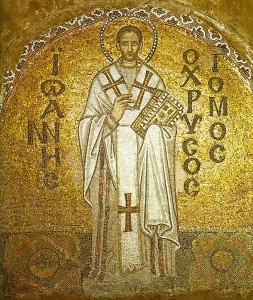
 John Chrysostom, public domain via Wikipedia
John Chrysostom, public domain via WikipediaDear ______:
Yes, your first preaching class brings a new and different challenge. I’ll confess I’m almost glad to hear you say you are terrified. I don’t want you to feel bad. But I do want you to take it seriously.
For a literary role model I offer you Frodo from Tolkein’s The Lord of the Rings.
At least in the movie version there is that great exchange between him and Aragorn, who offers counsel on Frodo’s calling to be the ringbearer.
Aragorn: Are you frightened?
Frodo: Yes.
Aragorn: Not nearly frightened enough.
Wise counsel for preachers: What you are dealing with in the pulpit is important, powerful, and potentially very dangerous.
Whether you know it or not you enter the pulpit with two great concerns: the revelation of God, and the life in Christ of the people who listen.
Handle the Scriptures well and you lead people toward growth, healing, salvation.
Handle the Scriptures poorly and you can do immeasurable harm.
So yes, of course you are terrified.
A Role Model for Your Preaching Life
But you need more than a literary caution. You need a role model for your preaching life.
I offer you St. John Chrysostom (c. 349-407). He was Archbishop of Constantinople. The name means “Golden Mouthed” and he got it for being such an amazing preacher.
There is a lot to admire in John Chrysostom — the Orthodox actually celebrate his life on three separate days (one of which is today, by the way).
Think of John Chrysostom this way: He lived and preached the biblical faith, no matter the cost.
He welcomed unpopular exiles even if they tainted his reputation.
He practiced simplicity rather than the splendor expected of one in high office.
He preached against lifestyles contrary to the gospel — even when the emperor’s wife got so mad he was sent into exile. Twice.
But the thing to focus on with St. John Chrysostom is not his willingness to “speak truth to power.” Too often preachers try to do that when “power” isn’t in the room. (Though here in Iowa the Rev. Dr. Pamela Saturnia recently did have the ear of a powerful visitor and spoke the truth with courage!)
Simple Biblical Preaching
What you should look for in Chrysostom’s sermons is the underlying simplicity. There is a three part approach woven into all of his sermons that I’ve read — though I’ve just scratched the surface.
He explains the biblical text read in worship so the people can understand it.
He relates that text to the whole of the biblical faith.
He helps the people see how that text and that faith connect with life and salvation — whether as challenge, or blessing, or invitation, or mystery.
That is what you should aim for in your sermon. Whether you structure it in three points, or four pages, or a narrative or whatever model comes into the curriculum, make sure it does what St. John Chrysostom’s sermons did.
Those three things. You can do those three things. Those are manageable goals.
If you do, your congregations will thank God for you.
Blessings,
Gary
The post Letters to a Young Pastor: A Role Model for Your Preaching Life appeared first on Gary Neal Hansen.
January 22, 2016
Letters to a Young Pastor: The Inner Life of the Writer
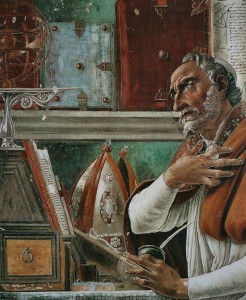
 Sandro Botticelli – Saint Augustin (public domain)
Sandro Botticelli – Saint Augustin (public domain)Dear ______:
Sorry to let so much time lapse between letters. Thanks for your note, and I’m sorry that writing is proving to be such a struggle.
You are in good company. If writing is part of what you do for a living then inner turmoil is probably another part.
You can find a lot of professional writers saying pithy things about how all you have to do is sit at your typewriter and bleed.
And you can find a lot of stories about famous authors driven to depression and addiction by the work.
But you don’t have to be a novelist or a poet to experience the challenge. In seminary you have to write papers. As a pastor you have to write sermons — Sunday has a way of coming around pretty relentlessly.
So you are pursuing a vocation where writing is required. You need a way to do that writing that gives you some life instead of sucking it straight out of your soul. And you need a way that won’t later require a 12 step recovery program.
There are ways to make that happen. I think thriving in your vocation depends on it.
Your Role Model: St. Augustine of Hippo
My quick suggestion for today is to take St. Augustine of Hippo (d. 430) as your role model. You won’t find a more prolific writer — just check the huge new collection of his works in translation in your seminary library.
Between major treatises and sermons you might wonder if he ever said a word that didn’t end up in a book. But that didn’t mean he was sloppy. His ideas shaped theology in the West more than any other thinker, and his writing is often truly beautiful.
The Inner Life of the Writer
But the reason I bring up St. Augustine is that he gave us a window into his inner life — the inner life of the writer who thrived on writing.
For that you need to pick up his Confessions. It is the greatest autobiography of the ancient world. It is also a book-long prayer.
Augustine prayed in writing. That is actually the point to build on if you want a healthy inner life as a writer.
He gives you great examples to imitate.
He talks to God, on paper, about his whole life story, looking and listening for traces of how God has been active all along the way.
He talks to God, on paper, about his current temptations and struggles, finding his way to wisdom and strength to face them.
He talks to God, on paper, about what he sees in Scripture — not preparing a sermon, but just exploring God’s Word in conversation with God.
Nurturing Your Inner Life As You Write
You can do those things. Take a bit of your daily prayer time and do just one of those tasks for a few minutes. Or take a few minutes as you are starting a paper or a sermon and write to God about it.
If you begin to make writing part of your daily practice of prayer, I think you will begin to turn the corner.
Blessings,
Gary
————
As Lent approaches you may find yourself thinking about renewing your own inner life. If you want information about an online class on prayer, using my book Kneeling with Giants, click here and I’ll be in touch.
(There are affiliate links in this post.)
The post Letters to a Young Pastor: The Inner Life of the Writer appeared first on Gary Neal Hansen.
January 18, 2016
Sources of the Faith We Love: St Athanasius and St Cyril
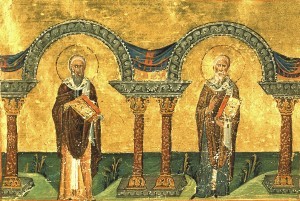
 We American Christians have a funny way of acting like we invented the faith. Or maybe it fell out, like an old letter, from between the pages our Bibles. We don’t know what we owe to people like St Athanasius and St Cyril.
We American Christians have a funny way of acting like we invented the faith. Or maybe it fell out, like an old letter, from between the pages our Bibles. We don’t know what we owe to people like St Athanasius and St Cyril.
If we are aware that Christianity has a past, we often see it mostly as a problem. We are more than happy to give it a makeover.
If we would only dig down a bit into history there are treasures waiting for us.
Leaders and teachers who gave us the faith we know.
Followers of Christ who were faithful at great cost.
If we enter into conversation with them, we just might find they can help keep us from our own excesses.
St Athanasius and St Cyril
Take, for example, St Athanasius of Alexandria (c. 296 – 373) and St. Cyril of Alexandria (c. 376 – 444).
If you are a Protestant you probably have never heard of either one — unless you’ve taken a Church history course in seminary.
But if you are Orthodox, you hear their names every time you come to the service of Matins before the Divine Liturgy.
And today the Orthodox Church remembers both St Athanasius and St Cyril, great bishops from the northern edge of Africa who shaped Christian theology forever.
St Athanasius
You can thank God for St. Athanasius if you know that Christ, born of Mary, is truly God incarnate. You might think this is plain enough in Scripture — and of course you can thank St. Athanasius for the boundaries of the Canon too, since he was the first to list the books as we do.
But in the 4th century the question was hotly debated:
A man named Arius convinced many that Jesus, born of Mary, is the incarnation of the created Son of the eternal Father.
St. Athanasius is the one who showed that Jesus is the incarnation of the eternal Son of the eternal Father — that both Father and Son are equally and always God.
Along the way, St. Athanasius showed that the Jesus Arius taught simply could not save us — if he is created he shares our fallen nature. He himself would need saving.
So the Council of Nicaea (325), which gave us the first version of the Nicene Creed of the East and West, was convinced by Athanasius’ views. They defined Christian understanding of Jesus in Athanasius’ way. Ever since, Christians have confessed faith in the Father,
And in one Lord Jesus Christ, the only-begotten Son of
God, begotten of the Father before all ages;
Light of Light, true God of true God, begotten,
not created, of one essence with the Father
through Whom all things were made.
St Cyril
A couple generations later St. Cyril had to deal with the implications of St Athanasius’ teaching.
Up in Constantinople, people had a special name for St Mary, the mother of Jesus. They called her “Theotokos.” It means “Bearer of God” or “Mother of God.”
The bishop, a man named Nestorius thought this was a very bad practice. Surely if people say Mary is the Mother of God they may be falling into a couple problems:
They might be saying Jesus is God but not human.
Or they may be getting into a crazy paradox where Mary is somehow older than God.
But down in Alexandria, St Cyril saw it differently: If the human Jesus who is born of Mary is truly God, then you simply have to say Mary is the Mother of God.
Nobody thinks Mary is older than God. That’s just silly.
But we do think the Son she bore is God. That’s just Christianity.
St. Cyril pulled out all the stops to defeat Nestorius. He made sure the Council of Ephesus (431) came out fully against him. He was not kind or fair. But he defended the faith.
Ever since then, well informed Christians of all stripes have stood with Athanasius in saying Christ is our God, and with Cyril in saying that Mary is therefore Theotokos, Mother of God.
If you find yourself a little surprised by that language you are not alone. Lots of today’s Christians find it easy to follow human Jesus but difficult to believe in divine Jesus. And ever since the Reformation, Protestants have had a hard time knowing what to do with Mary.
But we have a lot to learn from St Athanasius and St Cyril. Only a human Jesus who is also a divine Jesus can save us.
————
I’d love to hear from you in the comments! What is hard or easy about the divinity and humanity of Jesus? And what do you do with his Mom?
The post Sources of the Faith We Love: St Athanasius and St Cyril appeared first on Gary Neal Hansen.
January 13, 2016
How to Find a Life-Giving Rhythm

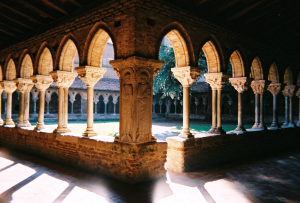 CC by Pst1960-SA 3.0
CC by Pst1960-SA 3.0Some lessons I have to learn over and over. Or maybe they are things that I just need to practice every day to learn at all. One of those lessons is how to find a life-giving rhythm in this chaotic world.
Chaos can come in the form of too many demands from too many directions. Work alone can pull you to pieces sometimes.
Add marriage, parenting, friends, church — after a while, each thing, even a favorite television show, can feel like it is pulling off a chunk of you as it pulls time away from every other demand.
Chaos.
Or chaos can come from the opposite direction: January finds me in a season of research and writing. I don’t have the usual enforced demands of classes, grading, and committee work. I’m free to work on my own — but that lack of structure can become its own kind of chaos.
 Think about getting yourself a drink of water. You pick up the pitcher and start to pour it — but hey, there’s no glass! The water goes everywhere. All you have is a mess.
Think about getting yourself a drink of water. You pick up the pitcher and start to pour it — but hey, there’s no glass! The water goes everywhere. All you have is a mess.
Chaos — because there is no structure.
But get a glass and your water has some structure.
Very helpful.
Bring it to your lips and drink.
Ah….
Prayer, and a life-giving rhythm
If you plan for it, prayer can be like the glass for the water, bringing order out of chaos.
When I was a pastor I was also finishing up my Ph.D. Thankfully, my contract included two weeks of study leave. I would spend them at a Benedictine monastery.
Early in the morning a monk would knock on my door. I would schlep myself to the chapel to pray Matins with the brothers, the first of the “hours” of the “Divine Office.”
I’d go out and come back around dawn for “Lauds” and “Prime.”
Then to my room for work, and back to the chapel for “Terce” at mid-morning.
Back to work, then back to chapel for “Sext” just before lunch.
Back to work, then back to chapel for “None” at mid-afternoon.
Back to work, then back to chapel for “Vespers” at the end of the workday.
Dinner, some quiet conversation, one last trip to chapel for “Compline,” and off to bed.
Before I tried it I feared I’d never get anything done with all that time in prayer.
Afterward I knew: this form of prayer, with all its structure, was like a glass to hold the water of life.
In two weeks at the monastery I did as much work as in three months back home.
Now with small children and a job it is often hard to get more than one of the hours into my day. But even that provides a useful pillar, a bit of structure around which the chaotic river of life must flow.
But as time goes on, especially in days devoted to research and writing, I can pray more than one of the hours.
Prayer can be the structure that turns life from chaos to order. Over and over it turns me from the mundane and worldly to the rich and eternal. Time and again I can live from a deep sense of being centered in God.
If I remind myself. If I keep coming back to the practice.
Now it’s your turn: Let me know in the comments how prayer impacts chaos in your life.
————
Lent is a great time to retool your prayer life. If you’d like to join me in an online prayer class click here to get on the waiting list.
The post How to Find a Life-Giving Rhythm appeared first on Gary Neal Hansen.
January 11, 2016
I Interview Laura Alary, “Make Room: A Child’s Guide to Lent and Easter”
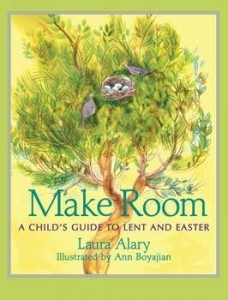
 This week I interview Laura Alary: a very dear friend, and a children’s author who has written a growing shelf of books. She takes both children and theology very seriously.
This week I interview Laura Alary: a very dear friend, and a children’s author who has written a growing shelf of books. She takes both children and theology very seriously.
My kids and I totally dig her books. Since her new kids’ book Make Room: A Child’s Guide to Lent and Easter is coming out just in time for Lent, she agreed to an interview here on my blog.
is coming out just in time for Lent, she agreed to an interview here on my blog.
And it is my first time as interviewer, so she’s mighty gracious too.
Interview: Laura Alary
GNH: When we first met you were wrapping up your Ph.D. in New Testament. How did you make the journey from biblical scholar to writer of children’s books?
Laura Alary: It may seem like a strange leap to make, but it happened very naturally. Writing a Ph.D. thesis had a strange effect on me. While I consider it a privilege to have had the opportunity to do that kind of focused work, the constant scrutiny and criticism—needing to edit and defend my words so carefully—left me unable to write. Even something as simple as a thank-you note left me struggling to find the right words. This grieved me because I had always written for pleasure and feared I had lost that ability. One day I decided to try writing a story for children, simply as a way of trying to find my way back to the joy I used to experience when I put pen to paper. My first efforts were awful, but they did get me unstuck.
At the same time this was happening, I was preparing for the birth of my first child. While my colleagues were interviewing for academic positions, I found myself wondering how all those years I had spent studying were going to work their way into this new vocation of nurturing and shaping a human life.
GNH: That sounds like quite a puzzle. Scholar, writer, mother, all pulling in different directions. What happened?
Laura Alary: The pieces came together one year during Advent when I was teaching an online course and several students got into an argument about the historicity of the biblical infancy narratives. They became quite bitter with one another. As I attempted to moderate the discussion, I found myself thinking of my own little boy and pondering how I could help him discover the wonder and truth of scripture in a way that would allow him to be curious and open to new ideas, not defensive and fearful.
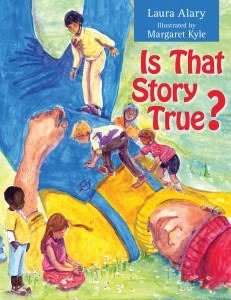 Out of that pondering came Is That Story True? That was my first published book for children and I have been writing ever since—and loving it!
Out of that pondering came Is That Story True? That was my first published book for children and I have been writing ever since—and loving it!
GNH: Very cool. Your new book invites children into the Church’s seasons of Lent and Easter. Some might think Lent would be kind of a downer for kids. How did you approach it?
Laura Alary: Guiding children through Lent is tricky. All that imagery of self-sacrifice and death can be quite frightening and easily misunderstood, especially by young people who are still forming their sense of self and identity. I remember feeling terrified by the message that I needed to let go of my self and die in order to follow Jesus. Deep inside, I had all sorts of hopes and dreams for what I wanted to do and be, but the message I kept hearing was that this was selfish and wrong.
When I had children of my own, I knew I needed a different approach to Lent. I wanted to retain the traditional themes and stories and symbols, but in a way that would not feel so negative and restrictive.
GNH: Sounds like this book has been brewing for a while. Did the books you wrote along the way contribute to the process?
Laura Alary: My first step in this direction was a story I wrote based on an Indian folk tale about a little boy who continually gives away things that come to him because he encounters people who need them more. In the end, this habit of generosity brings him what he most desires. Jesse’s Surprise Gift was an attempt to help children think about letting go and emptying out as positive things—making space for new possibilities.
was an attempt to help children think about letting go and emptying out as positive things—making space for new possibilities.
Another shift happened a few years later, during Lent. I had been reading Praying in Color by Sybil McBeth and wanted to share her ideas with my children. So one night we put on some quiet music, talked about people we knew who were sick or lonely, and started drawing prayers for them. I was struck by the joyful quality of the stillness that settled over the children as they became absorbed in their work. They lost themselves—in the best possible way—in their prayer.
GNH: How did that play into writing about Lent?
Laura Alary: Once again, I found myself thinking about all the other ways that emptying out and making room can be cleansing and life-giving.
For me, this was a new and wonderful vantage point from which to view Lent. Instead of being about limits—what is forbidden or unclean or wrong—the season became about opening up and creating space. The more I thought about it, and the more I meditated on the story of Christ in the wilderness, the more I felt that Lent really was about spaciousness—freedom, choice, openness to new ways of seeing and being, and above all, the awesome expansiveness of divine love.
GNH: I like that. The Church’s calendar graciously insists on making an opening, a space or time where there is room to ponder things that matter. Most of us wouldn’t bother otherwise.
Laura Alary: Make Room: A Child’s Guide to Lent and Easter is the fruit of my wondering and pondering. It presents a positive view of Lent as a special time for creating a welcoming space for God and others. It is full of practical ways children can experience the season with all their senses, and it connects these activities with specific moments in the story of Jesus, so that children can see for themselves that the things we do to mark this season are not ends in themselves, but are part of a life of following and imitating Christ.
GNH: It looks to me like writing is really a mission for you. What would you say you hope your books will do in the lives of their readers?
Laura Alary: In my book Mira and the Big Story, one of the characters says that the best stories make us bigger on the inside; they stretch our minds and hearts. That is what I hope my stories will do. I want to encourage children to ask questions, to wonder, to feel their connection to other people and the world around them, to experience awe, and to find holiness in the ordinary.
one of the characters says that the best stories make us bigger on the inside; they stretch our minds and hearts. That is what I hope my stories will do. I want to encourage children to ask questions, to wonder, to feel their connection to other people and the world around them, to experience awe, and to find holiness in the ordinary.
GNH: To what degree does your own family’s life weave its way into your books? And how do your kids respond to finding their experiences reflected in your books?
Laura Alary: Sometimes my family life comes out very explicitly. For example, How Do I Pray for Grandpa?  was written one summer when my father was extremely ill, and my sister-in-law had been diagnosed with cancer. My children were quite tickled to see themselves in that book, though they became rather possessive of it and objected when the illustrations did not look like them! I borrow ideas from other people’s families too, though. The idea for Victor’s Pink Pyjamas
was written one summer when my father was extremely ill, and my sister-in-law had been diagnosed with cancer. My children were quite tickled to see themselves in that book, though they became rather possessive of it and objected when the illustrations did not look like them! I borrow ideas from other people’s families too, though. The idea for Victor’s Pink Pyjamas  came from a conversation with a good friend whose son wanted to paint his room pink.
came from a conversation with a good friend whose son wanted to paint his room pink.
GNH: When your children were at the age for which you mostly write, what books did your children most love to have you read to them?
Laura Alary: There are too many to count! Bagels from Benny by Aubrey Davies was a favourite; so was Something from Nothing by Phoebe Gilman. They also loved the Frog and Toad stories and the George and Martha books.
GNH: Your books always deal with really useful theological issues at a child’s level. How would you describe the kinds of issues that prompt you to write?
Laura Alary: As a writer, I see myself as more of a teacher than an entertainer (though obviously I want children to enjoy my books!). Like any good teacher, I try to strike a balance between reflection the experience of children—what they are thinking about and wondering about—and stretching them beyond their own experience. I’m not sure there is any particular kind of issue that prompts me to write. I just try to be observant and to listen carefully to what children (my own and others) are wondering about. One of my favourite stories was written as a response to my son when he was trying to figure out where various Palaeozoic creatures would fit in the biblical creation account!
GNH: Who are your favorite, or role model, writers in your genre? Do you have living or literary mentors?
Laura Alary: I love the exquisite storytelling of Geraldine McCaughrean and Celia Barker Lottridge (both of whom do wonderful retellings of biblical stories as well as many other traditional tales); Madeleine L’Engle inspires me with her powerful imagination and fearless blending of science and theology; I admire Jon Muth for his wisdom and simplicity; Rukhsana Khan and Idries Shah are both gifted in the use of metaphor, and can make a simple story mean much more than it appears on the surface.
GNH: Do you have any advice for other parents who want to help their children engage with the faith in the way you do in your books?
Laura Alary: My biggest piece of advice is this: do not limit yourself to explicitly Christian books. There is a great blog by Hanna Schock called Picture Book Theology which celebrates the wisdom and wonder of “secular” picture books. Check it out.
GNH: As you look to the future, what can you say about the issues you are hoping to write on? Upcoming projects?
Laura Alary: I’m working on an Advent companion to Make Room. I’m also putting the finishing touches on a story about Lydia (the character from Acts), written from the point of view of her granddaughter. We need more good picture books about biblical women, especially those whose stories are often overlooked. I spend a lot of time asking myself, what stories need to be told that are not being told? I am drawn to stories that emphasize interconnectedness—the powerful bond we share as human beings. I’m also very keen on helping children explore the relationship between science and religious faith. But most of the time my ideas come to me out of the blue, so I can never be sure what my next project will be!
————
In a week I’ll be giving away a copy of Laura’s new book Make Room, to a randomly selected person who leaves a comment on this post! If you have a question for Laura, ask it. If not, let us know what your favorite children’s picture book is…
————
Laura Alary is a writer, teacher, storyteller, and mother of three. Born and raised in Halifax, Nova Scotia, she moved to Toronto for graduate studies and has lived in Ontario ever since. Laura studied Classics at Dalhousie University and theology at the Toronto School of Theology, graduating with an M.Div. from Knox College and a Ph.D. in New Testament from The University of St. Michael’s College. These days she writes picture books, teaches online courses, works as Christian Education Coordinator at a local congregation, and shares stories of all kinds with her own children.
You can connect with Laura, and get updates about upcoming books, on Goodreads, Amazon, Facebook, and at LauraAlary.ca.
————
There are affiliate links in this post.
Now go buy her books. You and your kids will love them.
The post I Interview Laura Alary, “Make Room: A Child’s Guide to Lent and Easter” appeared first on Gary Neal Hansen.
January 8, 2016
Review: A Goodness I Cannot Explain
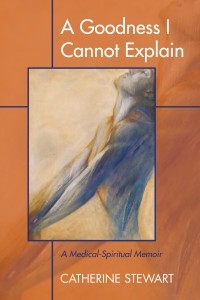
 A Goodness I Cannot Explain on Amazon
A Goodness I Cannot Explain on AmazonImagine: You start having odd symptoms. Your doctor does a scan of your head. There is a tumor. Two treatments are possible: each has very serious risks. How do you decide?
That is the situation Rev. Catherine Stewart faced a few years back. The journey that follows is the subject of her new book, A Goodness I Cannot Explain: A Medical-Spiritual Memoir.
Now since she actually wrote the book some years after the events, I won’t need to shout out “SPOILER ALERT” when I tell you that she lives.
Whew!
But knowing that she lives to, as it were, tell the tale, there is much good to be found here. The book will be a particularly good fit for two groups of readers.
For people facing medical crises
First, this is a book for people facing difficult diagnoses or complicated medical decisions–as well as those who love someone in such a situation. Cathy lays bare her inner world in the midst of struggles many of us will someday deal with.
The author is a Presbyterian minister who has delved deeply in to Catholic spiritual practices, particularly through association with Benedictine communities. She writes openly of her long experience with lectio divina and spiritual direction.
She lets us know from the beginning that her practice of lectio divina was the key to making her difficult medical decision, but we also see here held up through relationships with her family and her congregation, all of whom offered a variety of spiritual insights.
The process and the decision ultimately depended on these pillars of her spiritual life. This was not an abdication of the intellectual, but an embrace of the whole and the human.
That is, she did copious amounts of research into the science of her ailment and its treatments. But science, rather than giving clear objective answers, left her with risks and questions that could only be answered on internal criteria.
Her process was not simplistic. She did not simply hear a voice making the decision for her. And she did not measure the rightness of the choice she made on the medical success of the outcome.
She found a path that allowed her to know that God remained with her in the midst of her crisis, and God gave her permission to make a wise choice that fit.
So, if you need good company through your own health crisis, here’s a book for you.
For those who love spiritual memoir
The other audience for this book is those who love spiritual memoir.
There are different kinds of memoir, of course: Some tell a classic story with cliff-hangers, and a final crisis. Others chronicle gentler journeys and learnings during a particular season of life.
This is of the latter variety. The tone is measured, the pace is leisurely, and for the most part we know the outcome when we start. It is the inner journey that matters.
Cathy has cultivated a remarkable openness with us, her readers. As well as the primary medical decision we get to see her struggle with troubling symptoms, difficulties in recovery, and deep emotions.
The great thing, though, is that we see her face it all in the context of a very prayerful life. And in an era where many faithful Christians are longing for a richer, more engaged spiritual life she can be a role model.
Especially useful is her example of a modern variation on lectio divina. I’ve written on classic lectio, which is a prayerful engagement with a passage of Holy Scripture. Cathy, like a number of other passionate Christians I know, applies the framework of lectio to all kinds of things, including life situations like medical crises.
I think this modern variation works best if there is a foundation of the classic version of the practice, filling heart and mind with biblical insights. But taking lectio divina as a stance toward life can, as Cathy shows in her book, nurture a deep mindfulness and provide a way of listening to God.
The Benedictine tradition has clearly been fruitful for her. I was struck, though, by the thought that teachers of the Ignition tradition have a very great deal to offer in this regard, and a more direct path to the kind of spiritual life exemplified here. I wondered if Stewart might find herself drawn (and if readers who like her work might find themselves drawn) to writers like Margaret Silf.
You can pick up Cathy’s book on Amazon:
Giveaway
I’m giving a free copy of the book to a randomly selected reader of this post. Just leave a comment below to be eligible. (I’ll select the winner after the post is up for one week.) If you have a question for the author, maybe Cathy will stop by and answer..
Disclosures: Cathy is a friend, and I received a complimentary review copy of this book from the publisher. There are affiliate links in this post.
The post Review: A Goodness I Cannot Explain appeared first on Gary Neal Hansen.
January 6, 2016
What’s an Epiphany?
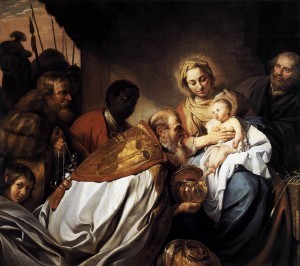
 In school when I was a kid we spent a month or so studying some novel. It it, my teacher said, the main character had an “epiphany.” Everyone but me knew the answer to a crucial question: “What’s an epiphany?”
In school when I was a kid we spent a month or so studying some novel. It it, my teacher said, the main character had an “epiphany.” Everyone but me knew the answer to a crucial question: “What’s an epiphany?”
What’s an Epiphany?
Now I can tell you: it is a moment of revelation. The character in that novel suddenly understood something.
The Church celebrates January 6 as THE Epiphany. It is a day of particular revelation in the course of Christ’s life.
Protestants are less likely to notice the Epiphany than either Catholics or Orthodox, for whom it is a major holy day. Maybe with a little exploration you’ll come to love Epiphany too.
The West: The Coming of the Magi
This is a moment in the Church year that has different associations for Christians in the West and the East. The differences are illuminating.
In the West, the major emphasis of January 6 is the revelation of Christ to the Gentiles. This is the day we remember that three mysterious non-Jews, Magi from the East, had discovered that a new king had been born.
 The Adoration of the Magi, Jan de Bray [Public domain], via Wikimedia Commons
The Adoration of the Magi, Jan de Bray [Public domain], via Wikimedia CommonsThey saw his star.
They came and found him.
They offered him valuable gifts.
And, most significantly, they worshipped him.
That’s altogether amazing:
Outsiders used their brains and their secular knowledge to find God’s promised Messiah. God gives the world the ability to find the Way. Pretty cool.
Foreigners gave Mary and Joseph the resources they would need to protect the infant Jesus. Soon they would flee to Egypt to save Jesus from Herod’s wrath. God uses outsiders to preserve the Life. Very cool.
The nations outside were the first to recognize and worship God incarnate. God shows his determination to bring the Truth to all. Super duper cool.
Suddenly we know: with the coming of the Magi God reveals that Christ’s saving work reaches to the ends of the earth — and, so, to people different from us.
The East: The Baptism of Christ
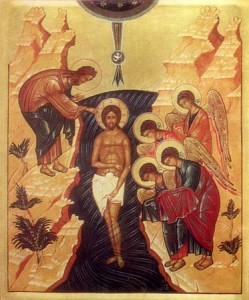 Icon of the Theophany of the Lord, public domain via Wikipedia
Icon of the Theophany of the Lord, public domain via WikipediaIn Eastern Orthodoxy (where they call the day “Theophany”) a completely different scene is remembered: the day the grown-up Jesus went to be baptized by John in the River Jordan.
In those days Jesus came from Nazareth of Galilee and was baptized by John in the Jordan. And just as he was coming up out of the water, he saw the heavens torn apart and the Spirit descending like a dove on him. And a voice came from heaven, ‘You are my Son, the Beloved; with you I am well pleased.’ (Mark 1:9-11, NRSV)
The Son is there: We know from John 1 that Jesus is the eternal Word who is himself God.
The Father is there: We hear his voice from heaven declaring Jesus, the Word, is his Beloved Son.
The Holy Spirit is there: Manifest as a Dove, the Spirit comes down from heaven to Jesus on earth.
Suddenly we know: with the Baptism of Christ God is revealed to be the Holy Trinity.
This is a really big deal for the Orthodox — as it should be for us all. This is the vivid revelation of the very nature of God. When you come to know the Christian God you come to know the One God in Three Persons.
This focus on the Trinity is not only clear from the icon of the day but from the first hymn sung in the morning service known as “Orthros”:
As You were baptized in the Jordan, O Lord,
then the worship of the Trinity became manifest,
for the voice of the Father bore witness to You,
naming You the Beloved Son;
and the Spirit, in the form of a dove,
confirmed the certainty of the word.
O Christ God, who appeared and illumined the world,
glory to You.
The Orthodox revel in the manifestation of the Trinity. But the Orthodox do not leave it with that. They think about all kinds of implications.
They have time. Orthros is a long service.
So in a later hymn they consider how this particular moment of revelation, this Theophany, is not just to human minds but to the whole of Creation:
Jordan River, tell us do:
What did you see and were amazed?
I saw naked Him whom none
can see, and shuddered in fear.
And how was I not to shudder at Him and be frightened?
The Angels, when they saw Him also shuddered in awe.
And heaven was astonished, and astounded was earth.
The sea recoiled along with all things
both visible and invisible.
For Christ appeared in the River Jordan,
to sanctify the waters.
At the revelation of the Triune nature of God, everything is astounded, from the angels and heaven where they dwell, to the earth itself and all created things.
Most specifically the waters are made holy by their participation in this wonder. And so I leave you with a video of the annual celebration of the blessing of the waters in Russia.
(The first seconds show the setup on a frozen lake, the second section is a bit of the liturgy, and from 1:30 on you see the extremely hardy faithful jumping in.)
Enjoy!
(They hymns in this post are from Fr. Seraphim Dedes’ inimitable “Digital Chant Stand.” The first is from the Festal Menaion, and the second was translated by Fr. Dedes.)
The post What’s an Epiphany? appeared first on Gary Neal Hansen.
January 3, 2016
Why We NEED 12 Days of Christmas

 CC by bmartz77 3.0
CC by bmartz77 3.0The culture has wrestled the “12 Days of Christmas” away from the Church. Let’s take those days back. Honestly, we NEED 12 Days of Christmas.
Confusion
We all know the phrase because of the song. You know: from the ground-nesting seed-eating bird somehow stuck in a fruit tree, to the extremely large percussion section.
We are made even more familiar with the phrase by annual marketing efforts: 12 days of bargains and that kind of thing. In this the Holy Birth of Christ gets twisted around in multiple ways.
First, the purpose of Christmas is turned into buying and selling.
Second, the 12 days are mistakenly moved backward into Advent.
Clarity
So to end all confusion let me say that December 25 is Day #1 of Christmas. The 12 days take us up through January 5.
The next season of the Church year begins with Epiphany on January 6.
Three Reasons We NEED 12 Days of Christmas
We really need the full 12 days of Christmas. I’ll give you three reasons. I hope you’ll add your own in the comments.
1. The birth of Christ is far too big a deal to celebrate with just one day. This is the day when God the Word became flesh and dwelt among us. Christmas is the beginning of God’s restoration of humanity, and of all creation.
That deserves more attention — especially when Christmas day festivities will not leave room to contemplate the mystery. (I posted earlier this week on the great mystery of Christmas. Check it out!)
2. By keeping the full 12 Days, Christians mark the genuinely Christian celebration. In our culture, Christmas as a day of gifts and gatherings has expanded well beyond those who care at all for Jesus. That is perfectly fine. I have to think God loves both joy and giving. He’s probably happy to have inspired it.
But Christians need that and more. By finding ways to mark the whole season of Christ’s coming, we remind ourselves of what is true and we quietly bear witness to the Truth.
3. In pragmatic terms, your kids will be much better off with 12 Days. I don’t mean they get more stuff. I’m saying they are better off spreading the stuff across a couple of weeks.
A lot of families go a bit overboard with the gift giving. If we have the financial means to give gifts, parents tend to give more than one thing to each kid. Then there are gifts from grandparents, who also have come across more than one choice item. And Aunts and Uncles. Possibly teachers. Maybe school friends. Other friends. You see where this is going.
My early Christmas memories are of opening everything all at once. Sure, it was a rush, seeing all of those new toys. But it went by so fast I couldn’t even remember who to say “Thank you!” to.
And then it was done. After a greedy glut of a Christmas morning, Christmas afternoon could be downright depressing.
Now that we have kids of our own, we ration out the presents. There is time to enjoy each one before moving on. One time when the kids opened up a marble run game the whole family stopped for an hour or so building complicated towers and machines to roll the balls through. We just enjoyed it.
It is better. It is saner.
And there are still things for them to look forward to, all the way to January 5.
The post Why We NEED 12 Days of Christmas appeared first on Gary Neal Hansen.



